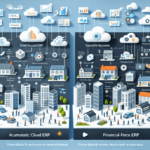FinancialForce ERP vs Acumatica Cloud ERP: An In-Depth Comparison
In the rapidly evolving business landscape, selecting the right Enterprise Resource Planning (ERP) system is crucial for streamlining operations and driving growth. Two prominent contenders in the ERP space are FinancialForce ERP and Acumatica Cloud ERP. This comprehensive comparison delves into their features, benefits, costs, and suitability for various business types to help you make an informed decision.
Understanding ERP Solutions and Their Importance
What is an ERP System?
An ERP system integrates various business processes into a unified platform, encompassing functions like finance, human resources, supply chain, and customer relationship management. This integration fosters efficiency, accuracy, and real-time data visibility across the organization.
Why ERP Systems are Essential for Modern Businesses
- Streamlined Operations: Automates and integrates core business processes, reducing manual efforts and minimizing errors.
- Real-Time Data Insights: Provides instant access to critical business data, enhancing decision-making and strategic planning.
- Improved Collaboration: Facilitates seamless communication and data sharing across departments, fostering teamwork and coherence.
- Scalability: Adapts to the growing needs of businesses, supporting expansion and increased operational complexity.
Overview of FinancialForce ERP and Acumatica Cloud ERP
FinancialForce ERP
FinancialForce ERP is a cloud-based solution tailored primarily for service-oriented businesses. Built natively on the Salesforce platform, it seamlessly integrates financial management with customer relationship management (CRM). Key functionalities include accounting, invoicing, revenue recognition, and billing, making it an excellent choice for organizations that prioritize financial automation and Salesforce integration.
Acumatica Cloud ERP
Acumatica Cloud ERP stands out as a versatile ERP solution designed to cater to a wide array of industries, including manufacturing, distribution, construction, and retail. It offers comprehensive modules covering financial management, project accounting, inventory, supply chain management, and more. Acumatica’s flexible deployment options and customizable features make it a robust choice for businesses seeking adaptability and scalability.
Key Features Comparison
FinancialForce ERP Features
- Native Salesforce Integration: Offers seamless connectivity with Salesforce, enhancing CRM and financial data synergy.
- Revenue Recognition: Automates revenue recognition processes to ensure compliance with accounting standards.
- Project Accounting: Manages project finances, tracks costs, and analyzes profitability effectively.
- Advanced Financial Reporting: Provides comprehensive reporting tools for detailed financial analysis.
- Automated Billing and Invoicing: Streamlines billing processes, reducing manual effort and minimizing errors.
- Cash Management: Enables effective cash flow management with real-time visibility into cash balances and forecasts.
Acumatica Cloud ERP Features
- Flexible Pricing Model: Allows businesses to pay only for the modules they need, enhancing cost-effectiveness.
- Advanced Inventory Management: Offers comprehensive tools for tracking and managing inventory efficiently.
- Project Accounting: Facilitates effective management of project finances and resource allocation.
- Robust Reporting Functionalities: Delivers insightful data analysis through powerful reporting tools.
- Mobile Access: Provides access to ERP data from any device, promoting flexibility and remote operations.
- Comprehensive CRM Capabilities: Manages the entire customer lifecycle, including lead generation and sales forecasting.
- Powerful Workflow Engine: Automates processes and streamlines operations with customizable workflows.
Functional Differences Between FinancialForce ERP and Acumatica Cloud ERP
Integration Capabilities
While FinancialForce ERP offers native integration with Salesforce, providing a unified platform for CRM and financial data, Acumatica Cloud ERP boasts a broader range of integrations with various third-party applications, offering greater flexibility for diverse business ecosystems.
Inventory Management
Acumatica Cloud ERP excels in inventory management with advanced tracking and optimization tools, making it suitable for businesses with complex inventory needs. In contrast, FinancialForce ERP focuses more on financial operations, offering robust billing and invoicing features but with more limited inventory management capabilities.
Pricing Models
FinancialForce ERP employs a subscription-based pricing model with monthly fees determined by the number of users and modules selected. On the other hand, Acumatica Cloud ERP offers a more flexible, per-module pricing structure, allowing businesses to tailor costs based on specific needs, which can be particularly advantageous for small to mid-sized enterprises.
Industry Focus
FinancialForce ERP is optimized for service-based businesses, leveraging its strong financial management and Salesforce integration. Conversely, Acumatica Cloud ERP caters to a wider range of industries, including manufacturing, distribution, and retail, offering customizable modules to meet diverse operational requirements.
Cost and Pricing Analysis
FinancialForce ERP Pricing
FinancialForce ERP operates on a subscription-based pricing model, with costs ranging from $1,500 to $4,500 per month. The pricing varies based on the number of users and the modules selected, making it essential for businesses to assess their specific needs to determine the most cost-effective package.
Acumatica Cloud ERP Pricing
Acumatica Cloud ERP adopts a flexible, per-module pricing strategy, allowing businesses to pay only for the functionalities they require. This approach can lead to significant cost savings, especially for small and mid-sized businesses that may not need comprehensive ERP features. Additionally, Acumatica offers both subscription-based and perpetual licensing options, providing further flexibility in budgeting.
Implementation and Maintenance Costs
- FinancialForce ERP: Implementation fees range from $10,000 to $50,000, contingent on the complexity of the deployment. Ongoing maintenance includes a support package with a customer success manager, 24/7 support, and regular updates.
- Acumatica Cloud ERP: Offers a flexible implementation model, allowing businesses to choose between self-implementation or partner-assisted deployments. Maintenance and support include a self-service portal with training materials and support ticket submission, alongside robust customer support options.
Compatibility with Different Business Types
FinancialForce ERP
FinancialForce ERP is best suited for companies heavily utilizing Salesforce, providing seamless integration and advanced financial management capabilities. It is ideal for service-based businesses that rely on Salesforce for daily operations and require robust financial automation.
Acumatica Cloud ERP
Acumatica Cloud ERP is versatile and caters to a broad spectrum of industries, including healthcare, manufacturing, construction, and retail. Its customizable modules and comprehensive feature set make it a suitable choice for businesses with diverse operational needs and those seeking a scalable ERP solution.
User Experience and Support
User Experience
- FinancialForce ERP: Offers a user-friendly interface integrated with Salesforce, known for its ease of use and efficient performance. Users benefit from intuitive navigation and a cohesive experience within the Salesforce ecosystem.
- Acumatica Cloud ERP: Features a comprehensive menu system with extensive options, which can be more complex but offers greater functionality. The platform is designed to accommodate a wide range of business processes, providing users with the tools they need to manage intricate operations.
Customer Support
- FinancialForce ERP: Provides support through a dedicated community portal, online chat, and phone support. Customers have access to personalized assistance and a wealth of resources to aid in problem-solving and system optimization.
- Acumatica Cloud ERP: Delivers support via phone, email, and live chat, with varying support levels based on the chosen pricing model. Additionally, Acumatica offers extensive training resources, including online tutorials and user forums, to enhance user proficiency.
Security Measures in FinancialForce ERP and Acumatica Cloud ERP
Security is a paramount concern for businesses handling sensitive data. Both FinancialForce ERP and Acumatica Cloud ERP implement robust security protocols to safeguard information.
- FinancialForce ERP: Adheres to global data privacy standards, incorporating advanced security measures such as role-based access controls, encryption, and regular security audits to protect financial and operational data.
- Acumatica Cloud ERP: Offers secure hosting environments with end-to-end data encryption, comprehensive administration tools, and compliance with industry-specific security standards. Acumatica also provides features like multi-factor authentication and detailed activity logs to ensure data integrity and protection.
Real-Life Case Studies: Success Stories
Companies Utilizing FinancialForce ERP
- Service-Oriented Businesses: Organizations that prioritize financial management and leverage Salesforce for client interactions benefit significantly from FinancialForce ERP’s integrated solutions.
- Professional Services Firms: Firms requiring detailed project accounting and revenue recognition find FinancialForce ERP particularly advantageous.
Companies Utilizing Acumatica Cloud ERP
- Manufacturing Firms: Benefit from Acumatica’s advanced inventory and supply chain management features.
- Construction Companies: Utilize Acumatica’s project accounting and resource allocation tools to manage complex projects efficiently.
- Retail Businesses: Leverage Acumatica’s inventory management and CRM capabilities to enhance operations and customer engagement.
Final Verdict: Choosing the Best ERP for Your Business
Selecting the right ERP system hinges on your business’s specific needs, industry, and growth aspirations.
- Choose FinancialForce ERP If:
- Your business is service-oriented and relies heavily on Salesforce for CRM.
- You require robust financial management and advanced billing features.
- You prefer a subscription-based pricing model aligned with your Salesforce ecosystem.
- Choose Acumatica Cloud ERP If:
- Your business spans multiple industries or has diverse operational needs.
- You seek a flexible, per-module pricing model to optimize costs.
- You require comprehensive inventory, supply chain, and project management tools.
In summary, both FinancialForce ERP and Acumatica Cloud ERP offer powerful solutions tailored to different business requirements. Evaluating your organizational needs, budget constraints, and long-term goals will guide you in selecting the ERP system that best aligns with your strategic objectives.






















